 Weird Stuff
Weird Stuff  Weird Stuff
Weird Stuff  History
History 10 Bizarre Friendly Fire Incidents in Military History
 Technology
Technology 10 Modern Technologies That Accidentally Imitate Ancient Magic
 Mysteries
Mysteries 10 Mysteries of the Human Genome
 Weird Stuff
Weird Stuff 10 Things So Rare They’ve Only Been Found Once
 History
History 10 Legends Whose Last Moments Undid Their Glory
 Health
Health 10 Futuristic Ideas to Treat Common Medical Problems
 Weird Stuff
Weird Stuff Ten Surreal Attempts to Reverse Baldness
 Facts
Facts 10 U.S. Government Contingency Plans for the Unthinkable
 History
History 10 Weird Distractions from the Great Depression
 Weird Stuff
Weird Stuff 10 Superstitious Beliefs That Once Consumed Entire Cultures
 History
History 10 Bizarre Friendly Fire Incidents in Military History
 Technology
Technology 10 Modern Technologies That Accidentally Imitate Ancient Magic
Who's Behind Listverse?

Jamie Frater
Head Editor
Jamie founded Listverse due to an insatiable desire to share fascinating, obscure, and bizarre facts. He has been a guest speaker on numerous national radio and television stations and is a five time published author.
More About Us Mysteries
Mysteries 10 Mysteries of the Human Genome
 Weird Stuff
Weird Stuff 10 Things So Rare They’ve Only Been Found Once
 History
History 10 Legends Whose Last Moments Undid Their Glory
 Health
Health 10 Futuristic Ideas to Treat Common Medical Problems
 Weird Stuff
Weird Stuff Ten Surreal Attempts to Reverse Baldness
 Facts
Facts 10 U.S. Government Contingency Plans for the Unthinkable
 History
History 10 Weird Distractions from the Great Depression
10 Disgusting Delicacies From Around The World
From caviar to filet mignon, every culture and society has foods that are considered delicacies. As such, these dishes are often thought of as the most delicious and prestigious foods one can sample.
However, delicacies vary greatly from country to country. In many instances, the favorite foods of one country can be viewed with disgust and aversion by those from other places. One person’s filet mignon can look like gruel to another. Louise Fresco is quoted as saying, “Food is something holy”; these delicacies, however, can be viewed as terrors straight from Hell.
10 Casu Marzu
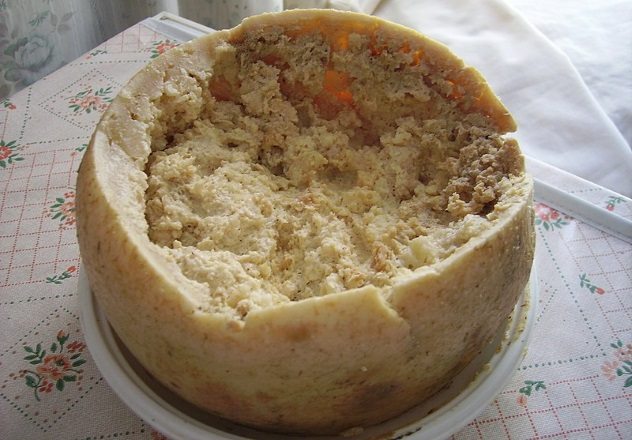
When one thinks of cheese, the mouth begins to water, and images of cheddar dance through the mind. In Sardinia, however, cheese has taken a horrendous turn. Casu marzu is considered a highly prized delicacy by the people of Sardinia. But what makes this cheese so special? Casu marzu translates to “rotten cheese,” and that’s only the beginning of its disgusting story. What really makes it a delicacy is the fact that the it’s teeming with live maggots.
Casu marzu, or maggot cheese, begins its journey to disgust as a simple pecorino cheese, soaked in brine, smoked, and left to cure in cellars. Enter the maggots. Cheese producers take a slab of cheese destined to become casu marzu and leave it out in the open, breaking the skin to allow flies to enter the cheese and lay eggs.[1] This particular fly, the cheese skipper, lays many eggs; multiple flies may enter the cheese, filling the middle with thousands upon thousands of eggs. Then eggs then hatch, and the maggots begin doing what they do best: eating and defecating. As the maggots eat and poop, the enzymes produced by their bodies rot and putrefy the inside of the cheese so that when it is opened for consumption, the inside is a gooey, sticky, gummy mass filled with countless amounts of live maggots .
There are, however, hazards to dining on this delicacy. The maggots don’t like to be upset. When the cheese is scooped, spread, or disturbed in any way on its way to the mouth, the maggots will jump and launch themselves up to 15 centimeters (6 in) in distance. That close to one’s face, one may considering donning a pair of safety goggles to enjoy this rancid feast. In the past, casu marzu was banned by the European Union due to hygiene and food safety regulations; the EU didn’t want people eating rotten cheese and live insects. However, the illegality of the cheese was overturned, as Europe considered the cheese to be a traditional food of the Sardinian people and therefore not under judicial jurisdiction.
9 Hakarl
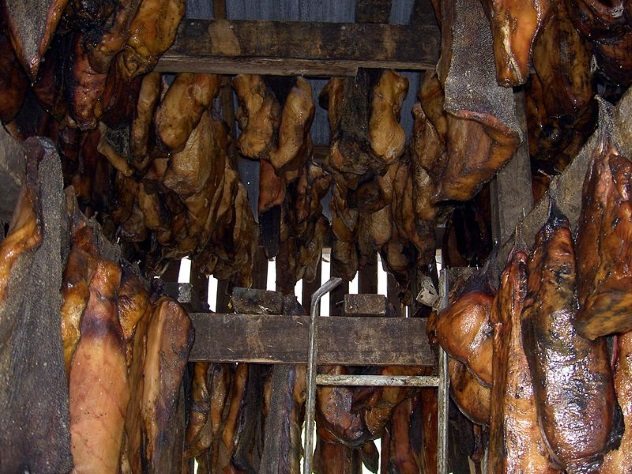
To many, sharks are quite frightening: large teeth, black, dilated pupils, and a lust for blood. In Iceland, sharks are even more terrifying as the national delicacy—fermented, rotted, and awash in an odiferous cloud of ammonia. Hakarl is a traditional food of Iceland that can be traced back to the time of the Vikings. When Vikings began to establish homesteads on Iceland, they discovered that sharks, namely the Greenland shark, were abundant in the waters around the island, thus becoming a major food source. The Vikings quickly learned that the flesh of the Greenland shark was toxic to humans, so to prepare it for consumption, they discovered a way to to purify the meat.
So, just how is the shark turned into such a delicacy? It’s a long and disgusting story. After catching the shark, it is quickly beheaded. To eliminate the toxins, trimethylamine oxide and uric acid, a hole is dug, and the shark is placed inside. Rocks are placed on top of the shark. The pressure of the stones causes the toxins to leak out. This takes six to 12 weeks. During this time, the shark itself begins to rot and ferment within the ground. Once purification is deemed a success, the shark is pulled from the ground, chopped into long pieces, and hung to dry. Drying takes even longer; several months will pass before hakarl preparers are certain the shark is ready. How does one know when rotten shark is ready for consumption? When the ripe, rotten smell is at its peak, and a dry, hard, brown crust forms on the hanging shark meat.[2]
Though the thought of eating hakarl seems disgusting to outsiders, the people of Iceland consider it a traditional national delicacy. During the Icelandic holiday of Thorrablot, hakarl is consumed by participants to honor the ways of old. Chef and TV personality Anthony Bourdain actually tried hakarl once during his trip to Iceland and claimed that it was the “worst, worst, worst, worst, thing” that he had ever tasted, while chef Gordon Ramsay tried it during a television broadcast and immediately vomited into a bucket. So the next time you’re in Iceland and you smell the hint of rot on the air, don’t despair. It’s not a rotting body; it’s the national delicacy of Iceland.
8 Huitlacoche
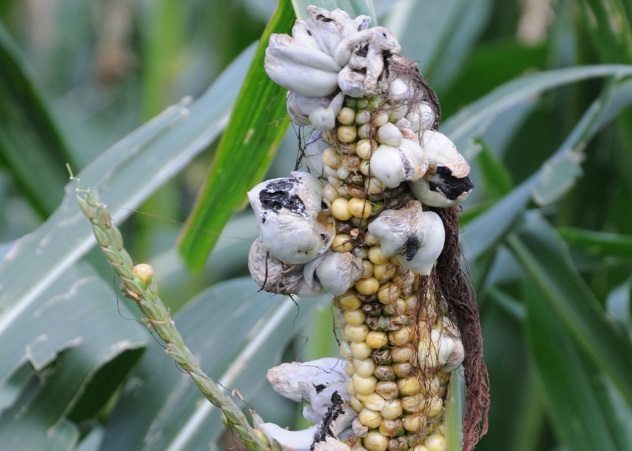
Mexico is renowned for its delicious cuisines. From carne asada to the humble taco, Mexican cuisine is beloved by millions. There is, however, one food that is considered a delicacy by native Mexicans that others would be rather shocked to find on their plates. Huitlacoche is often known as “corn smut,” “fungus,” or “Mexican truffle,” but this delicacy is a plant disease that afflicts corn. The disease grows in puffy, grey globules that look somewhat like river rocks.[3] Though this fungal disease is considered a plague by most, in parts of Mexico, the fungus is scraped from leaves and actually put onto the kernel to promote growth.
Huitlachoche has been known by the indigenous tribes in Mexico for eons, but during the second half of the 20th century, this fungus became a delicacy that has inundated nearly all aspects of traditional Mexican cuisine. Many describe the flavor as delicate and slightly smoky, comparing it the taste of morels. Most of those who try the fungus, however, agree that the texture, nature, and flavor of the fungus make it an acquired taste.
Huitlacoche can be prepared in many ways, often thrown into many dishes as a flavoring element, or it can be used to create soups and sauces. Many even eat the globular fungus by itself, relishing in its delicate flavor and soft, mushy texture. When cooking with huitlacoche, one must be warned: When heated, the fungus turns from grey to jet black, looking a lot like the ink of a squid. If you’re feeling adventurous next time you’re in Mexico, ditch the portobello and ask for a bit of corn smut in your dish instead.
7 Kiviak
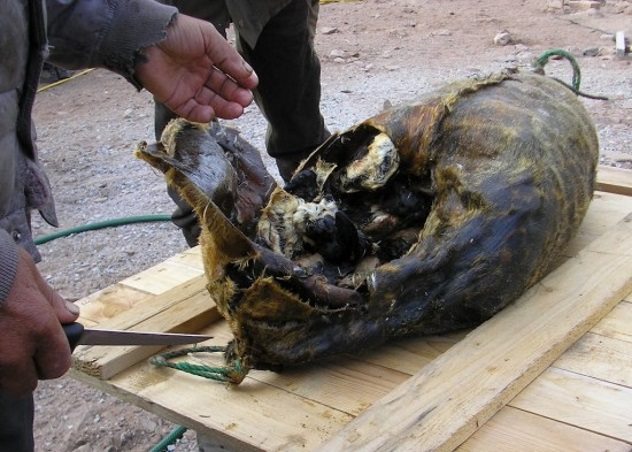
Holidays are a time for joy, family, and good food. In Greenland, holidays are just as special, and their celebrations would not be complete without the Inuit delicacy of kiviak. To prepare kiviak, the Inuit start by gathering their meats. First, they capture and slaughter a large seal. The seal is then disemboweled and greased. Then, hundreds of auks, a bird similar to a penguin, are caught and killed. The bodies are stuffed, whole, into the body of the dead seal. After the whole birds have been stuffed into the seal carcass, the seal is sutured shut and covered with heaps of grease to prevent maggots from entering the body. A hole is then dug, and the seal is placed, auks and all, inside and covered with heavy stones.
After several months, usually close to the Christmas holiday, the seal is dug up. The sutures which were holding the auks inside the fermenting seal body are cut to reveal the birds. The auks are then eaten, bones and all, as they have become soft due to the fermenting process. The intestinal fluids are often sucked right out of the bodies of the birds and enjoyed as a rancid juice. This same intestinal fluid is also often used for sauces for other foods and dishes.[4]
Though this delicacy seems very extreme, it has its foundations in practicality. During the winter months in Greenland, hunting and fishing are extremely dangerous due to snow and shifting ice. Kiviak is a way for the Inuit to have plenty to eat during these times. The turducken just got really intense in Greenland.
6 Virgin Boy Eggs
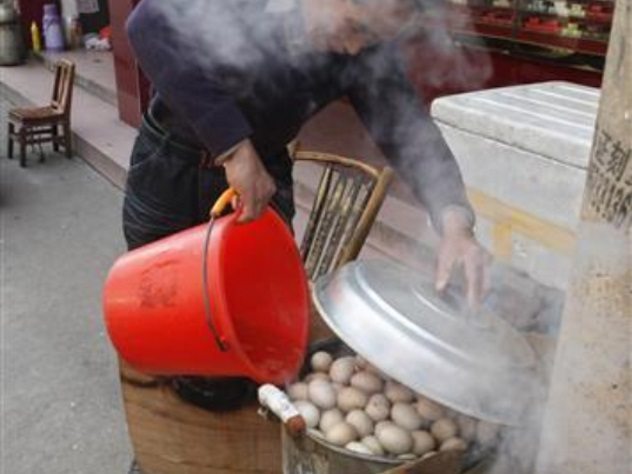
Eggs are a staple of nearly every culture. They are delicious, versatile, and full of protein. However, in China, one of their delicacies has a little more: urine. Virgin boy eggs are a delicacy in Dongyang. Each year in the spring, eggs are boiled in the urine of young virgin boys, usually aged ten and under. During the springtime pee-fling, urine is collected from nearly every boy under ten. Buckets are placed in elementary schools across the city, where the boys’ urine is collected. Many people even carry around empty bottles while out in the city to retrieve urine from boys if their parents are willing to allow them to collect it. The boys must be in good health and not be suffering from any illness due to concerns for food safety.
Once the urine is collected, then comes the process of actually preparing the virgin boy eggs. After a long day of urine collection, preparers empty the pee into preparation receptacles. Chicken eggs are then placed to soak in a bath of boys’ urine and then boiled in more urine. Once the eggs reach hard-boiled status, they’re removed from the urine, cracked, peeled, and then placed back into the urine to simmer. This urine simmering process can take nearly an entire day and can cost a buyer twice what a regular chicken egg would cost.
This delicacy has been around since ancient times in China, and eating them is supposed to boost one’s health. Many claim that eating urine-soaked eggs will prevent a variety of ailments, but the most notable is preventing heatstroke. Though many find this delicacy to be odd and somewhat harmful depending on cooking and urine quality, China has deemed the tradition of cooking eggs in little boys’ urine lawful and part of the “intangible culture heritage” in Dongyang.[5]
5 Shirako
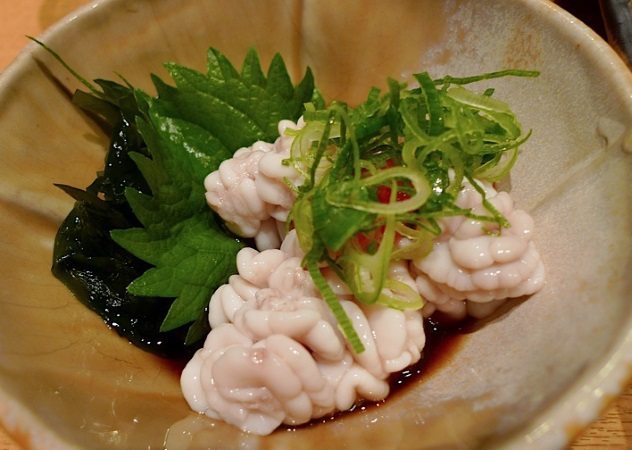
Japan is notorious for its weird eats, and shirako is definitely one of the oddest. Shirako is milt, or to put it bluntly, the sperm sacs and the accompanying semen of male fish. The little sacs of semen are considered a delicacy in Japan. Shirako is harvested from many different types of fish, including cod, anglerfish, salmon, and pufferfish. It is harvested during the winter months, as this is when these different fish are producing the most seminal fluid, meaning the shirako will be more delicious.
Once harvested, the shirako can be prepared in many different ways to please the adventurous palate. Those who wish to eat it raw, or “fresh,” are presented with a semisolid white blob that looks like soft, scrambled brains. Lightly cooked, the shirako becomes even creamier, turning into a seminal fluid–based custard.[6] For those not quite ready to indulge in fresh shirako, it can be doused in tempura batter and deep-fried, creating a creamy, crunchy sperm sac for consumption.
Shirako is often considered the most prized part of the fish, thus adding to its delicacy status. In some places, tiny portions of shirako sell for more than $100. The most prized shirako, however, is that of the pufferfish. Fugu-based shirako is considered the grandest delicacy in the realm of sperm sacs.
4 Century Eggs
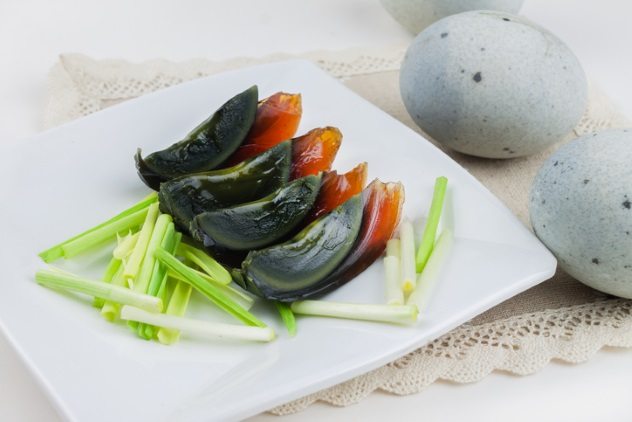
Scrambled, sunny-side up, or boiled eggs are commonplace, and many enjoy them. But another egg-based delicacy in China has been turning stomachs for millennia. Going by many names, such as the century egg, thousand-year egg, or pidan, this eggy creation is a favorite in rural China. So what exactly is it? A century egg is either a quail, duck, or chicken egg that has been fermented and preserved using an atypical array of ingredients. First, a large vat is filled with black tea, salt, lime, and freshly burned wood ashes and is left to cool overnight. After this vat has reached maximum potency, duck, quail, or chicken eggs are added in. The eggs then soak in this mixture from anywhere from seven weeks to five months, ensuring they are fermented and preserved properly.[7]
After they are fully prepared, one can enjoy the century egg. This is where things get a bit more grotesque. The egg becomes a jiggly, wiggly nightmare. Imagine an egg with the consistency of Jell-O. The white of the egg turns colors ranging from amber to nearly black. The yolk becomes a hard ball that is dark grey or green. One can see snowflake-like patterns on the shell; this is where a fungus has taken hold of the egg and adds what some call beauty. The egg also reeks of ammonia, which only adds another hint of disgust to the black, eggy mess. This delicacy is often sliced into pieces and served as a side dish or enjoyed on its own.
3 Bird’s Nest Soup
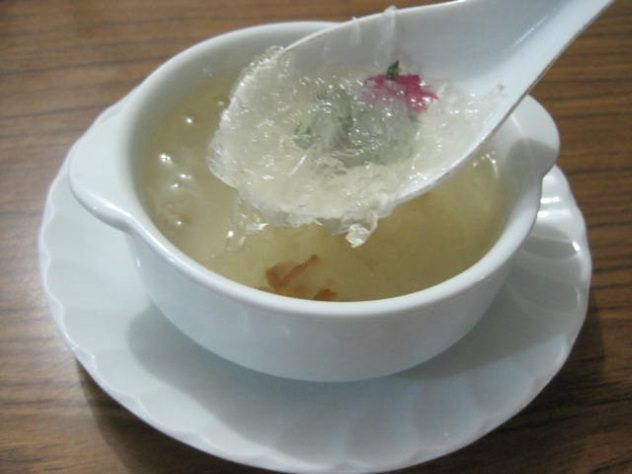
When one thinks of eating birds’ nests, it brings up images of sticks and straw. But the Chinese delicacy of bird’s nest soup is a lot more intriguing than that. Bird’s nest soup is made from the nests of cave-dwelling swiftlets. These birds make their tiny, special nests out of something easy to find for most birds: saliva. The birds use tons of their own spit to weave and build intricate nests on the side of the cave walls in which they live. To harvest the tiny nests, men must climb ladders to great heights within the cave to peel the little spit abodes down for consumption. The nests are then taken and used to create a soup or a gelatinous dessert which is claimed to taste like a Slush Puppie drink.
Though seemingly less stomach-turning than many of the other featured foods, this spit delicacy is nasty in more ways than one. The harvesting of the birds’ nests themselves is a disgusting act. The swiftlet is highly endangered. Because of the harvesting, which happens up to three times per year, the bird populations are decreasing. The nests are taken before the swiftlet has time to lay an egg, thus forcing the small bird to create another nest during breeding season. Sometimes, the birds don’t lay, preventing another generation of birds from being born.[8] So this delicacy may be one of the past if regulations on the practice of harvesting nests for soup are not moderated.
2 Shiokara
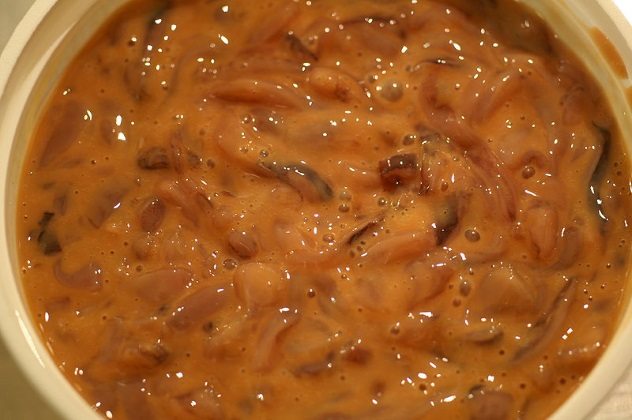
A regional delicacy of Japan is shiokara. Unassuming name, right? Well, this dish is a nightmare in a bowl. Often passed on by Japanese natives, shiokara is not for the faint of heart. Shiokara is salted, fermented marine animals, most commonly cuttlefish. To create this dish, one simply catches a cuttlefish, slices it up into pieces, and then mixes the meat with the guts and juices found within the cuttlefish itself.[9] After preparation, the cuttlefish and its body juices are allowed to ferment and rot for up to a month. When the month has passed, the container is opened, and what is found inside is the stuff of foodies’ nightmares. The cuttlefish and guts have turned into a viscous brown paste with the smell of stinky, rotten seafood.
Japanese natives who consume the dish agree that the best way to eat shiokara is to simply swallow everything, slices and guts, in one giant gulp and then follow it with an even larger shot of whiskey. Though cuttlefish shiokara sounds awful, just know that there are other different types of fish-and-guts concoctions you can enjoy, including squid, sea urchin, fiddler crab, and sea cucumber. Some insist it tastes like anchovies. I guess you can be the judge of that one.
1 Stinkheads
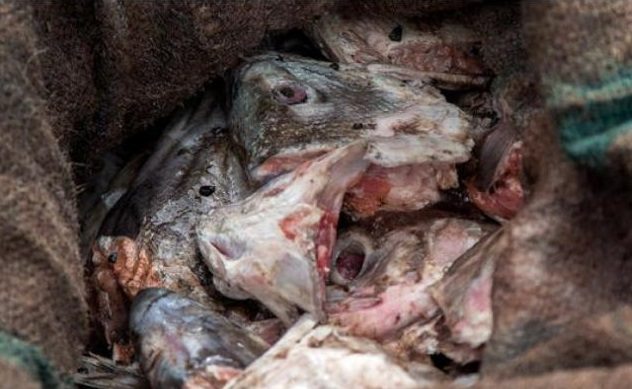
Alaska is ripe with many animals that have become a staple for people living in one of the coldest places on the globe, and native Alaskans have created one of the weirdest delicacies on the planet. To prepare the perfect tepa, aka “stinkhead,” a whitefish or salmon is caught and slaughtered. The head and guts are then put into a wooden barrel, covered in burlap, buried, and allowed to ferment for a week. After the stinkhead has been in the ground long enough, it is removed and eaten as is. “As is” happens to be a rotten, putty-like mass of fish goop.
Though considered disgusting by most, native Alaskans view the stinkhead as a delicious traditional delicacy. However, enjoying it comes at great costs. Alaskan natives suffer from the highest rates of botulism worldwide due to the consumption of their rotted delicacy. Fermented food contains amounts of botulism that can be removed through modern cooking and preparation practices. Though some have taken to using somewhat “safer” methods for preparing stinkheads, botulism is still found and is wreaking havoc on the natives of Alaska.[10]
Hi! I’m Theta! I am a full-time librarian with a penchant for writing, animals, and all things obscure. I love traveling, my pets, Game of Thrones, and reading.
For more dinner ideas to send your guests running, check out Top 10 Disgusting Foods and 10 More Utterly Disgusting Foods.








